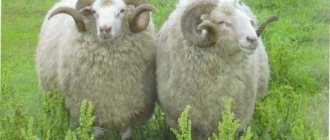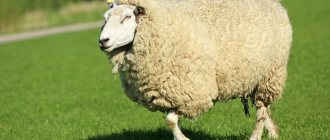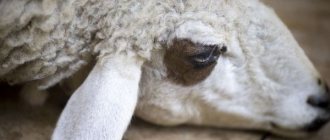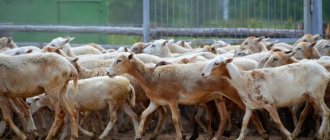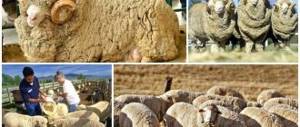Scabies in sheep occurs mainly in the cold season, when there is a lack of vitamins in the animal's diet. This is not one disease, but several, they are caused by different pathogens. This article will help you figure out what parasites cause scabies in sheep and tell you how to fight the disease.
Scabies mite in a sheep
Causative agents of scabies
There are several tens of thousands of species of arthropods, most of which do not harm animals. But there are also those who lead a parasitic lifestyle. They feed on the blood or skin fragments of sheep and other livestock. Among the skin parasites that infect sheep, there are three types of arthropods:
- itching;
- cutters;
- skin beetles.
Each type of pathogen listed causes similar symptoms of scabies. However, the parasites themselves differ from each other in the structure of their mouthparts, body size and other features.
Sarcoptic mange
This type of scabies is not very common in sheep. It is caused by the itch mite. This parasite primarily affects young individuals with weak immune systems. Coarse wool breeds of sheep are more susceptible to infection.
The peculiarity of this parasite is that it has a gnawing mouthpart, thanks to which the tick makes holes and passages in the surface layer of the skin - the epidermis. There, females lay eggs, which subsequently gradually turn into sexually mature individuals, emerge on the surface of the skin, and mate. Then the process is repeated.
Attention! The itch mite primarily affects the area of the ears, nose, and lips.
The symptoms of sarcoptic mange are as follows:
- Redness in the ear area and below.
- Hair loss. Bald spots gradually appear in the affected areas.
- Itching - the animal rubs against surrounding objects.
- Sometimes body temperature rises.
- Weight loss, stunting.
The mite that causes sarcoptic mange
Sarcoptic mange often occurs in a chronic form, when inflammation either intensifies or subsides. If treatment is not started, mites will gradually invade new areas of the body. As a result, the animal weakens, is stunted and loses weight.
Attention! Sarcoptic mange is dangerous because it leads to anemia and exhaustion, from which the sheep can die. A bacterial infection often penetrates the scratching area, which leads to suppuration.
Psoroptosis
Another type of scabies is sheep psoroptosis. It is caused by another pathogen, the skin mite. It differs from the previous parasite in the structure of the oral apparatus and the size of the body; the cuticle is larger. The peculiarity of the parasite is that it does not penetrate the skin, but lives on its surface. It feeds on blood and lymphatic fluid, which the tick obtains by piercing the skin.
Psoroptosis also worsens mainly in autumn and winter, and subsides in the warm season, but recovery does not occur on its own. If a tick attacks an animal, it continues its activity on its body.
Skin mites target other parts of the sheep's body. They are localized:
- in the croup area;
- on the sides;
- on the sacrum.
Attention! The limbs are the last to be affected. If a sheep's wool has peeled off and crusts have appeared on its legs, we can conclude that the animal has been suffering from scabies for a long time.
Symptoms of the disease are similar to sarcoptic mange:
- formation of bald spots and scratches on the skin;
- the appearance of crusts in places where arthropods are localized;
- restlessness, itching;
- exhaustion.
Attention! Sheep shearing cannot get rid of psoroptosis. In this case, the mites penetrate the skin folds of the animal and continue their activity there.
Chorioptosis
The least dangerous type of scabies is chorioptosis. This disease is caused by carpet beetles. They are very different from previous parasites. There are suction cups on their limbs that help arthropods to stay on the skin of animals and move. These parasites do not injure the skin; they use dead epithelial cells and hair particles as food.
Chorioptosis mite
Clinical signs of chorioptosis in sheep:
- itching in the extremities;
- scratches, wounds on the legs;
- the appearance of bald spots on the limbs, then in the scrotum, back and udder;
- sick sheep are depressed and inactive;
- with severe damage, lameness develops.
A characteristic difference between chorioptosis is that the disease first affects the limbs of the animal. Later, the mites spread to the croup and back. Although the parasites do not cause mechanical damage to the animal, sheep experience itching. It occurs due to irritation of nerve endings caused by the movement of mites on the skin.
Sarcoptic mange
A disease caused by parasitic mites. Relatively rare. It mainly affects young animals. Representatives of coarse-haired breeds are more susceptible. The main difference between zeds is their place of residence. This parasite is localized under the epidermis (upper layer of skin). The female tick gnaws holes in the deep layers of the animal's skin, where it lays eggs. The eggs hatch into larvae that transform through molting into a first-order nymph. Nymphs, together with the growing and sloughing skin of the host, gradually move to the surface, go through the stage of secondary molting, turning into a second-order nymph. The latter, also called teleonympha, molts again and passes into the imago stage - a sexually mature individual capable of reproduction.
Subsequently, the cycle is repeated many times, each new individual, damaging the skin of the infected animal, forms a new focus of inflammation.
Typically, sarcoptic lesions in sheep are observed in the area:
- lips;
- nose;
- eye;
- ears.
Since the source of infection is sick animals, in suckling lambs clinical manifestations of sarcoptic mange are observed in areas of the body that have the greatest contact with the mother’s fur.
The disease is manifested by very severe itching, forcing animals to constantly rub the affected parts of the body against various objects or the ground. Unbearable itching often leads to scratching, injury, the addition of pyogenic microflora and the development of areas of inflammation.
The skin in the affected area is red, swollen, and there is an increase in local temperature. The hair in the lesions is thinned out, and alopecia is observed. The disease occurs predominantly in a chronic or subacute form, tends to attenuate, reduce the intensity of clinical signs in the summer and worsen in the cold season. It is worth considering that self-healing with sarcoptic mange is not observed. Without taking appropriate measures, the pathological process spreads to new areas of the skin until a generalized form develops.
Sick animals are developmentally delayed, have poor weight gain, and the quality of their coat decreases.
Diagnostic methods
Having noticed anxiety in sheep, as well as signs characteristic of scabies: baldness, the appearance of scratches on the body, crusts, it is necessary to immediately separate sick individuals from apparently healthy ones. Next, you need to invite a veterinary service worker to carry out diagnostics. Even during the initial examination, the veterinarian can guess what type of scabies he is dealing with. To clarify the diagnosis, he will take skin scrapings from sick individuals.
The resulting sample will be examined under a microscope. As already mentioned, it is easy to distinguish itch mites from cutaneous mites. The former have a gnawing type of mouthparts, while the latter have a piercing-sucking type. In addition, the structure and body size of parasites also differ. The carpet beetle can be seen even without a microscope, using a magnifying glass.
When making a diagnosis, the veterinarian must exclude metabolic disorders in sheep, allergies, eczema, as well as various dermatomycosis, skin diseases caused by pathogenic fungi.
Psoroptosis
The most common type of scabies in sheep. Caused by parasitism of skin mites. Unlike itches, cuticles do not penetrate the thickness of the skin, but live on its surface. The method of feeding of the parasite is also different - while prurituses literally gnaw passages under the epidermis, then cutaneous parasites, having a piercing-sucking type mouthparts, pierce the upper layer of the skin and feed on lymph and tissue fluids.
Mechanical injuries caused by mites lead to the development of severe itching.
In addition, components of the parasite’s saliva that enter the wounds can also be considered pathological factors.
The favorite places for localization of these arachnids are:
On the limbs and head, lesions are either not noted or occur as a last resort.
The disease, like the previous one, tends to worsen in the cold season and subside in the summer. There is also a decrease in the intensity of invasion due to cutting. At the same time, a complete cure does not occur; on shorn sheep, mites continue to exist and develop mainly in the skin folds.
The source of infection is sick animals and contaminated equipment. An outbreak of the disease can result from contact of a sick shorn sheep with its unshorn brethren. The development of the disease leads to thickening of the skin in the affected areas, hair loss, and the formation of scabies that serve as protection for the parasite.
Sick animals experience severe anxiety, cannot graze normally, and lose weight to the point of complete exhaustion.
How to treat scabies in sheep?
Insecto-acaricidal drugs are used to treat scabies. In veterinary pharmacies you can buy the following anti-tick products:
Creolin
- Neocidol;
- Creolin;
- Hexalin;
- Hexatalp;
- Chlorophos (0.5%).
These preparations can be used to treat sheep skin by spraying, as well as in the form of baths.
Before starting treatment, it is necessary to soften and remove crusts from the surface of the animal’s skin. The wool is pre-cut. Treatment with acaricidal preparations is carried out on sick animals two or three times with an interval of 10 days. Conditionally healthy individuals are treated once.
Attention! Before starting treatment, carefully read the instructions for the drug.
There is another way to cure scabies in sheep - using an Ivermec injection (analogous to Ivermectin). The drug is administered subcutaneously or intramuscularly twice with an interval of 10-14 days. Dosage for sheep – 0.2 ml of product for every 10 kg of body weight. Some farmers do not use this method of treatment because they consider it expensive.
Reference. Ivermek is also used to prevent scabies and other diseases caused by skin parasites.
Prevention
Since scabies is most often transmitted through direct contact of healthy animals with sick ones, it is necessary to carefully check all new sheep arriving on the farm for the disease. They are subject to mandatory treatment with acaricidal agents and quarantine for a period of 30 days. After this period, it is advisable to invite a veterinarian to examine the animals, after which they will be allowed into the pens.
In autumn and winter, it is important to maintain the immunity of animals by adding vitamins and microelements to the diet. The pens must be kept clean. Every time the flock leaves the pens and goes to remote pastures, all manure should be removed and the premises should be disinfected. Sheep should not be allowed to come into contact with people who come from farms unaffected by scabies. It is forbidden to import equipment onto the farm from points where cases of scabies have been reported. A healthy flock of sheep is not allowed onto pastures, where animals infected with scabies were driven away, for a month and a half.
The removal of animals from farms is permitted only after a year has passed since the last case of scabies was detected. This is done under the supervision of a veterinary service worker after treating departing animals with Hexachlorane or another product. 2 months before sheep are removed from the farm, they should be placed in separate pens, where a veterinarian will periodically examine the animals. After this period, he will issue a document confirming that the sheep that leave the previously unfavorable farm are healthy.
All types of scabies in sheep are dangerous, as they spread quickly and cause damage to the farm. It is much easier to follow preventive measures to protect your flock from parasites than to treat sheep later. Many farmers regularly use injections against various types of parasitic mites, for example, Ivermec or similar drugs, although this is an expensive procedure.
Preventive actions
To avoid treating sheep for ticks, care must be taken to reduce the likelihood of parasite infestation. Firstly, you need to carefully examine the surface of the skin and coat from time to time in order to detect the presence of parasites in time. This is especially true in the spring, when ticks become active. If they are found on any individual, you need to immediately separate it from the rest and transfer it to a separate room. You can return back only after complete recovery.
Secondly, treat not only the infected animal with drugs, but also the entire livestock prophylactically. Clear the stall of bedding and manure, burn the wool shorn from sick sheep. Treat the sheepfold with creolin, chlorophos, Lysol, repeat after 2 weeks to minimize re-infection with the next generation of lice. When purchasing new animals, inspect their fur and quarantine them for a while.
Any domestic sheep can become infected with ticks and lice. This can happen on pasture or after contact with sick animals. Treatment for parasites - treatment with anti-acaricidal veterinary drugs. Not only infected individuals, but also everyone else on the farm must undergo treatment. Untreated animals reduce productivity, may suffer from infectious diseases or even die.
